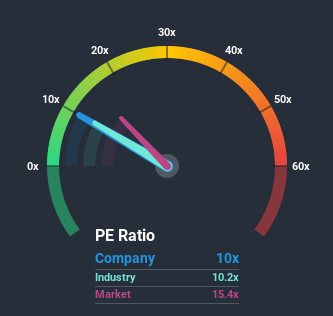Direct Line Insurance Group plc's (LON:DLG) Business And Shares Still Trailing The Market

Want to participate in a short research study? Help shape the future of investing tools and earn a $40 gift card!
Direct Line Insurance Group plc's (LON:DLG) price-to-earnings (or "P/E") ratio of 10x might make it look like a buy right now compared to the market in the United Kingdom, where around half of the companies have P/E ratios above 16x and even P/E's above 30x are quite common. Nonetheless, we'd need to dig a little deeper to determine if there is a rational basis for the reduced P/E.
Direct Line Insurance Group hasn't been tracking well recently as its declining earnings compare poorly to other companies, which have seen some growth on average. It seems that many are expecting the dour earnings performance to persist, which has repressed the P/E. If this is the case, then existing shareholders will probably struggle to get excited about the future direction of the share price.
Check out our latest analysis for Direct Line Insurance Group
Where Does Direct Line Insurance Group's P/E Sit Within Its Industry?
It's plausible that Direct Line Insurance Group's low P/E ratio could be a result of tendencies within its own industry. It turns out the Insurance industry in general also has a P/E ratio lower than the market, as the graphic below shows. So this certainly goes a fair way towards explaining the company's ratio right now. Ordinarily, the majority of companies' P/E's would be compressed by the general conditions within the Insurance industry. Ultimately though, it's going to be the fundamentals of the business like earnings and growth that count most.
Keen to find out how analysts think Direct Line Insurance Group's future stacks up against the industry? In that case, our free report is a great place to start.
Is There Any Growth For Direct Line Insurance Group?
In order to justify its P/E ratio, Direct Line Insurance Group would need to produce sluggish growth that's trailing the market.
If we review the last year of earnings, dishearteningly the company's profits fell to the tune of 11%. However, a few very strong years before that means that it was still able to grow EPS by an impressive 45% in total over the last three years. So we can start by confirming that the company has generally done a very good job of growing earnings over that time, even though it had some hiccups along the way.
Turning to the outlook, the next three years should bring diminished returns, with earnings decreasing 0.5% per year as estimated by the twelve analysts watching the company. With the market predicted to deliver 8.2% growth per annum, that's a disappointing outcome.
In light of this, it's understandable that Direct Line Insurance Group's P/E would sit below the majority of other companies. However, shrinking earnings are unlikely to lead to a stable P/E over the longer term. There's potential for the P/E to fall to even lower levels if the company doesn't improve its profitability.
The Final Word
It's argued the price-to-earnings ratio is an inferior measure of value within certain industries, but it can be a powerful business sentiment indicator.
As we suspected, our examination of Direct Line Insurance Group's analyst forecasts revealed that its outlook for shrinking earnings is contributing to its low P/E. At this stage investors feel the potential for an improvement in earnings isn't great enough to justify a higher P/E ratio. Unless these conditions improve, they will continue to form a barrier for the share price around these levels.
A lot of potential risks can sit within a company's balance sheet. Our free balance sheet analysis for Direct Line Insurance Group with six simple checks will allow you to discover any risks that could be an issue.
If you're unsure about the strength of Direct Line Insurance Group's business, why not explore our interactive list of stocks with solid business fundamentals for some other companies you may have missed.
This article by Simply Wall St is general in nature. It does not constitute a recommendation to buy or sell any stock, and does not take account of your objectives, or your financial situation. We aim to bring you long-term focused analysis driven by fundamental data. Note that our analysis may not factor in the latest price-sensitive company announcements or qualitative material. Simply Wall St has no position in any stocks mentioned.
Have feedback on this article? Concerned about the content? Get in touch with us directly. Alternatively, email editorial-team@simplywallst.com.

 Yahoo Finance
Yahoo Finance 
